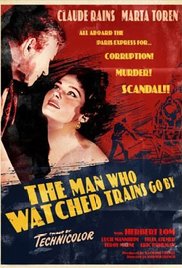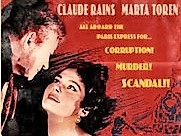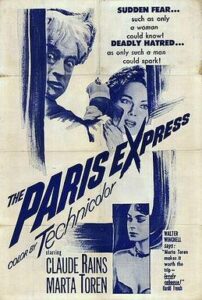The Man Who Watched Trains Go By *** (1952, Claude Rains, Märta Torén, Marius Goring, Herbert Lom, Anouk Aimée, Ferdy Mayne, Felix Aylmer) – Classic Movie Review 3,772
The 1952 British suspense crime thriller film The Man Who Watched Trains Go By has four or five inestimable advantages. Notably, it is based on a Georges Simenon novel and stars Claude Rains.
Writer-director Harold French’s 1952 British suspense crime drama thriller film The Man Who Watched Trains Go By has four or five inestimable advantages.
First, it is based on the excellent 1938 novel L’Homme qui Regardait Passer les Trains by Georges Simenon, the creator of Maigret.
Second, it stars Claude Rains, who goes properly over the top as Kees Popinga, a meek and mild Dutch manufacturing company head clerk accountant, who witnesses something shocking at work, exploits the situation and goes to Paris to spend some of the crooked money that results.
Third, it also stars Marius Goring as Inspector Lucas of the Paris Suretè, the policeman who is doggedly tracking Popinga’s trail.
Fourth, it co-stars Herbert Lom as Julius de Koster Jr, Popinga’s boss, the Dutch shipping company’s owner who is obsessed with Parisian woman Michelle Rozier (Märta Torén), bankrupts his own company, burns the incriminating ledgers and plans to run off to Paris with the company payroll when he is caught in the act by his accountant.
It’s up to Popinga to try to dodge the law as he plans to meet up with Michelle. But she is only after his money so she can take off with her lover Louis (Ferdy Mayne).
This interesting, if minor version of the Georges Simenon story is rather uncertainly scripted and directed, but it remains quite involving, thanks to the intriguing plotting and characters of the Simenon original, as well as the hard work of a very useful cast, all giving earnest, expert performances.
A fifth asset is Otto Heller’s lovely Technicolor cinematography on location in Amsterdam and Paris, though it is the very kind of film you expect to see in black and white.
It is a very neat, compact, and rather satisfying thriller, running just 82 minutes.
Also in the cast are Anouk Aimée, Herbert Lom, Ferdy Mayne, Felix Aylmer, Eric Pohlmann, Lucie Mannheim (Goring’s real-life wife), Gibb McLaughlin, Michael Nightingale, Robin Alalouf, Joan St Clair, Michael Alain, Jean Debreaux, and Roy Purcell.
Co-screen-writer Paul Jarrico was originally uncredited as he was blacklisted by movie studio bosses during the McCarthy era, In 1950, a friend gave his name to the House Un-American Activities Committee. On refusing to testify before HUAC, Jarrico was blacklisted and his passport was confiscated. No American studio was willing to make his scripts into movies, and without a passport he could not go abroad to work.
The film was released in the UK in December 1952 (London). It was released in the US in 1953, mundanely retitled as The Paris Express.
The Man Who Watched Trains Go By is directed by Harold French, runs 82 minutes, is made by Josef Shaftel Productions and Raymond Stross Productions, is released by Eros Films (UK) MacDonald Pictures (US), is written by Harold French and Paul Jarrico (originally uncredited), based on the novel L’Homme qui Regardait Passer les Trains by Georges Simenon, is shot in Technicolor by Otto Heller, is produced by Josef Shaftel, Raymond Stross and David Berman (associate producer), and is scored by Benjamin Frankel.
The cast are Claude Rains as Kees Popinga, Marius Goring as Lucas, Märta Torén as Michele Rozier, Ferdy Mayne as Louis, Herbert Lom as Julius de Koster Jr, Lucie Mannheim as Maria Popinga, Anouk Aimée as Jeanne, Eric Pohlmann as Goin, Felix Aylmer as Mr Merkemans, Gibb McLaughlin as Julius de Koster Sr, Michael Nightingale as Popinga’s clerk, Lucie Mannheim, Robin Alalouf, Joan St Clair, Michael Alain, Jean Debreaux, and Roy Purcell.
The prolific Belgian-born Georges Simenon (1903-1989) wrote more than 200 novels as well as many shorter works – between 400 and 500. Simenon’s creation, Inspector Jules Maigret, who appeared in about 75 works, ranks only after Sherlock Holmes and Poirot as the world’s best known fictional detective. About 132 movies and TV shows are based on Simenon’s books.
© Derek Winnert 2016 Classic Movie Review 3,772
Check out more reviews on http://derekwinnert.com





